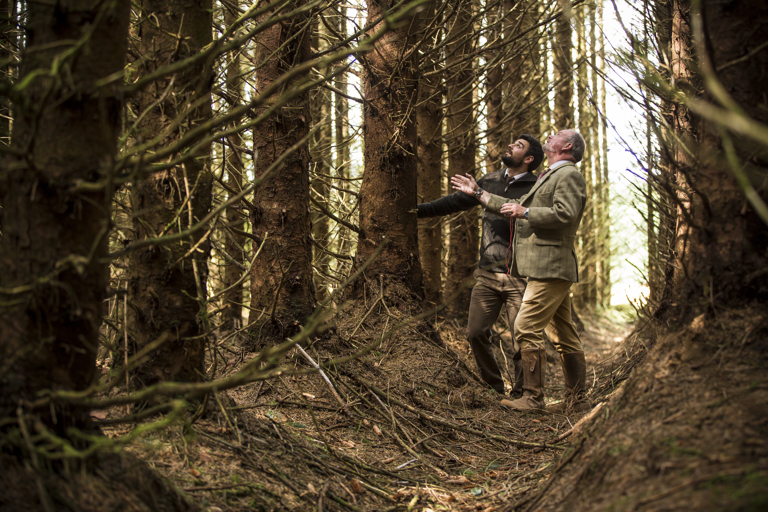Time to spruce up the voluntary carbon market
There’s currently a debate underway in the UK around where plantation forestry i.e. fast-growing timber producing forestry, fits into the voluntary carbon market system, the Woodland Carbon Code (WCC). Similar discussions are being had in other parts of the world - as globally we analyse how to deal with the climate change challenge we all face.

Accepting the fact that industry, society and individuals all need to do more to reduce emissions, we also need to start sequestering the CO2 already in the atmosphere. In the UK the land use sector accounted for around 12% of our annual emissions but globally, land use is estimated to produce just under a quarter of the planet’s annual emissions. However, as well as contributing to the problem, land use can also form part of the solution, with areas of land being converted from net emitters to net carbon sinks.
Natural Climate Solutions form a key part of this positive climate action. Implementing more sustainable agricultural (both crops and livestock) and forestry practices, as well as protecting intact natural habitats and restoring degraded ones, has the potential to soak up 25-30% of global annual emissions by 2030 - according to some estimates. Planting new forests is a major component of this effort but we need to get the trees in the ground so they can “do their thing” as soon as possible. I’m talking speedy CO2 soak-up in action.
According to the WCC carbon calculator, one hectare of oak, growing at Yield Class 4 (YC is a measure of growth rate – the higher the number, the higher the timber yield or “faster” the trees grow) on mineral soils, with the site having been prepared with low intensity cultivation, deer fencing, and two weeding applications would soak up 33 TCO2e within the next 30 years. A like-for-like one hectare of Sitka spruce, growing at YC24 (the WCC being limited to YC24, whereas we know many spruce crops planted today are exceeding this level), will sequester 256 TCO2e in that same time – a 676% increase in carbon sequestering potential on a hectare for hectare basis.
Long-term oak woodland does of course provide more “permanence” given that these trees may not be planned for harvest and a valuable semi-natural woodland habitat will be created - a point which we shouldn’t undervalue. On the other side of the balance, each spruce (or any high yielding productive timber crop) hectare is producing in-demand timber and fibre, within a relatively short time scale of 30-45 years, displacing high emission materials like concrete, steel and plastics and helping accelerate the required transition to a low-carbon or circular bio economy. Then what happens? After harvest, the site is replanted (usually within 18 months in the private sector) and the next generation crop of fast-growing trees goes to work again. In the face of a climate change emergency and a truly limited period of less than 30 years - during which time it must be addressed - the pivotal role of fast-growing tree crops must not be underestimated.
There seems to be a disconnect between the Government’s climate change ambitions, the WCC’s “additionality” tests (i.e. proving a project is not financially viable without carbon monetisation), the need for urgent action and the CO2 sequestering and storing credentials of timber-producing forestry. The fact that the economics of timber-producing forestry make sense also make it difficult to pass the registration requirements to allow trading of carbon credits.
The UK has the aim of planting 30,000ha per annum by 2050 to meet its climate change targets. It’s currently planting half of that. Yes, the forestry investment sector is buoyant, but a key driver of that is the recognition of the crucial role woodlands, including those growing large quantities of “industrial” timber, will play in our transition to a more sustainable future. UK forestry activity needs to scale-up quickly. It effectively needs to redouble efforts to meet planting targets. This will require more people to do the work (anyone you speak to in the forestry world is flat-out already) and, most critically, there needs to be more land freed up where trees can be planted.
Perhaps injecting easier-to-access carbon finance will act as further stimulus to really ramp up planting rates? Unlike timber income, you do not need to wait 35-40 years for significant cash returns. With carbon income you can sell carbon credits earlier in the lifecycle of the woodland and/or at periodic intervals to smooth out a lumpy cashflow.
This sharpens my view that we need to continue the development and refinement of the UK’s voluntary carbon market, adjusting the system in a way which does not penalise positive activities but one which helps us add scale to much-needed planting activity.

